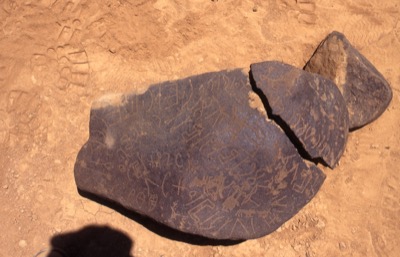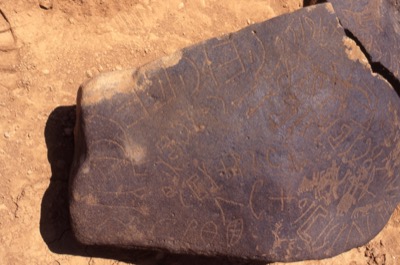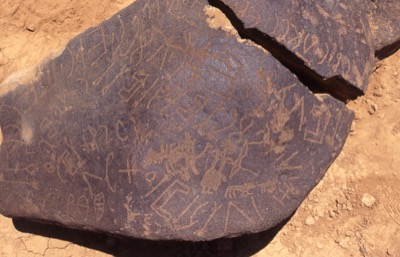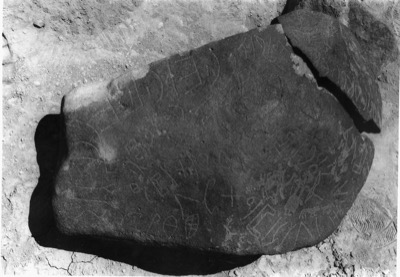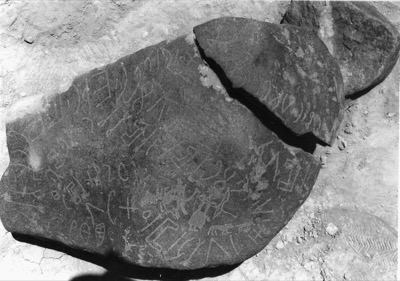Siglum: RQ.A 10 Script: Safaitic
Transliteration
l ms¹k bn ḥ{d} bn s¹ḫr bn ḥd bn mḥrb ḏ- ʾl fr{ṯ} w [[]]s¹rt ʿl- mlk h- s¹lṭn s¹n{t} bnḫr ʾmlk lmṣy b- ʿs²r mʾn w b- mʾty frs¹
Translation
By Ms¹k son of {Ḥd} son of S¹ḫr son of Ḥd son of Mḥrb of the lineage of {Frṯ} and he served in a military unit under the possessor of authority {the year} Bnḫr ʾmlk lmṣy with ten mʾn and with two hundred horsemen.
Commentary
The text is carved in a semi-square version of the script around a small drawing. Parts of the text are badly abraded.
The first ḥd has a stray line, thicker than the letter, in the ḥ, and a crescent, again in thicker lines, above the d. A second w was carved before s¹rt but was then cancelled with three lines crossing it. The h- before s¹lṭn was originally carved as a ʾ and its lower fork was then scratched over. Unfortunately, the letters after bnḫr are extremely difficult to interpret and it can be seen on the photographs that the letter which was read as k in our initial reading, followed by Al-Jallad (2015: 276), is of a completely different shape to the other examples in the text and both this letter and the one before it have been damaged. It should also be noted that Al-Jallad's reading (2015: 276) omits the letters lmṣy after the supposed ʾml{k}.
The expression s¹rt ʿl- occurs in two other Safaitic inscriptions, in one, KRS 1024, we find s¹rt ʿ{l-} ḫr hdy which we have translated "he served {under} Ḫr the commander", literally "he served, Ḫr being commander", compare Arabic ʿalay-hi amrun "command lies upon him, he is in command" (Lane 2145a and see Macdonald 2014:160, n. 78). The other occurrence is in C 2076: s¹rt ʿl- {ḥ}dd ʾbgr b- ʾlf rgl w mʾt f [r]s¹ "he served [in an army unit] on [literally against] the borders of ʾbgr with a thousand foot soldiers and a hundred horsemen" (see Macdonald 2014:160, n. 78). In the present text we follow Al-Jallad's translation (2015: 149), rather than those proposed in Macdonald 2014:160, n. 78.
The end of the inscription, b- ʿs²r [r]mʾn w b- mʾty frs¹, appears clear despite the two damaged letters in ʿs²r. These were previously thought to be the letters ʿ z and it was suggested that they may have been used as numbers (Al-Jallad 2015: 93–94). However, it now seems more likely that they are part of the word ʿs²r and that the [r] of the following word, rmʾn, assimilated to the [r] of ʿs²r. Al-Jallad has explained rmʾn as derived from rmy "archers" or "lancers" (2015: 339). On mʾty see Al-Jallad 2015: 37.
Subjects
Genealogy
Lineage
Military
Date (s1nt)
Country: Syria
Region: Rif Dimašq
Site: Riǧm Qaʿqūl A
Site number: 51
Present Location: In situ
Find date: 1995
Field collector: SESP team
Survey: Safaitic Epigraphic Survey Programme (SESP)
Notes: “Rijm Qaʿqūl A” is about 900 m to the south-east of the Ruḥbah water tower, on the right bank of Wādī Shām before it arrives in the Ruḥbah. It is a large cairn with a few ruined houses and very few inscriptions.
The name "Riǧm Qaʿqūl" was applied by nineteenth-century visitors to at least four large outcrops at the southern end of the Ruḥbah, to the south and south-west of the modern water tower. This helps to explain the curious fact that there is no overlapping between the "Riǧm Qaʿqūl" copies of de Vogüé (de Vogüé 1868–1877: nos. 212–215, 217, 219–224, 226–234, 389) and Waddington (de Vogüé 1868–1877: nos. 235–253, 388, 390–393, 397–400), Wetzstein (1860: nos 41–48, and at "a mound 10 minutes from Riǧm Qaʿqūl", nos 68–88) and Dussaud/ Macler (1903: nos 30–51, 53–124), and only in a very few cases between those of de Vogüé and Waddington. We only identified the site visited by Wetzstein (Riǧm Qaʿqūl A) and by but have not yet found those where de Vogüé /Waddington and Dusaud/Macler worked. The inscriptions we found at Riǧm Qaʿqūl A were all texts copied by Wetzstein and no one else. It is likely therefore that this is the place he regarded as "Riǧm Qaʿqūl".
Associated Drawings: An archer in an izār (sarong) with a bow and arrow a camel and dogs.
References:
Al-Jallad, A.M. An Outline of the Grammar of the Safaitic Inscriptions. (Studies in Semitic Languages and Linguistics, 80). Leiden: Brill, 2015. Pages: 37, 93–94, 149, 276, 339
[KRS] Inscriptions recorded by Geraldine King on the Basalt Desert Rescue Survey in north-eastern Jordan in 1989 and published here Number: 1024
Lane, E.W. An Arabic-English Lexicon, Derived from the Best and Most Copious Eastern Sources. (Volume 1 in 8 parts [all published]). London: Williams & Norgate, 1863-1893. Pages: 2145a
Macdonald, M.C.A. ‘Romans Go Home’? Rome and other ‘Outsiders’ as viewed from the Syro-Arabian Desert. Pages 145-163 in J.H.E. Dijkstra & G. Fisher (eds), Inside and Out. Interactions between Rome and the Peoples on the Arabian and Egyptian Frontiers in Late Antiquity. (Late Antique History and Religion, 8). Louvain: Peeters, 2014. Pages: 160, n. 78
[C] Ryckmans, G. Corpus Inscriptionum Semiticarum: Pars Quinta, Inscriptiones Saracenicae Continens: Tomus I, Fasciculus I, Inscriptiones Safaiticae. Paris: E Reipublicae Typographeo, 1950–1951. Number: 20176
URL of this record (for citation): http://krc.orient.ox.ac.uk/ociana/corpus/pages/OCIANA_0036328.html
